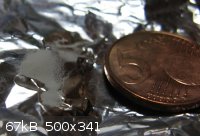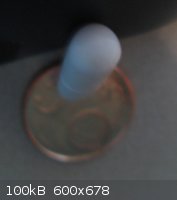benzeentje
Harmless

Posts: 17
Registered: 19-3-2012
Member Is Offline
Mood: No Mood
|
|
PTFE stirring bar dissolved?
Hi all,
I'm new to this forum, altough i have a very technical schooling of chemistry. Today i received my first heated stirring hot plate, and decided to
test it. I used one of my stirring bars, that i used before and never gave any problems.
After a while, when the water i was trying to boil reached about 80-90°C, the liquid started to turn blurry. I thought it was dissolved oxygen
bubbles. After a while, when the water had boiled, i turned the stirrer off and removed the erlenmyer from the heater. Only then i noticed that there
were flocks forming in the liquid and starting to coagulate.
When i took the stir bar out of my liquid, i noticed it had changed its form slightly from round to triangular. I filtered out the flocks, but only
got a very, very fine dust. There were no inpurities in the water that could have caused thisn since this was tap water. It wasnt some salt going out
of solution neither. I tried to dry the collected dust and took a photograph. I used a IKA Combimag RCT. I am 100% sure that my stir bar is lab grade
teflon, and it has sustained temperatures of 100°C and more. Notice that this fine dust i pictured is maybe 1/200 of what was present when i was
boiling this.
TL;DR
Could it be that my PTFE stir bar melted, altough i did not reach the melting point of teflon?
Source:http://en.wikipedia.org/wiki/Polytetrafluoroethylene
 
|
|
|
zoombafu
Hazard to Others
  
Posts: 255
Registered: 21-11-2011
Location: U.S.
Member Is Offline
Mood: sciencey
|
|
It sounds like your stir bar had something wrong with it, because I have taken a stir bar to temperatures greater than that, and it has been fine.
|
|
|
Bot0nist
International Hazard
    
Posts: 1559
Registered: 15-2-2011
Location: Right behind you.
Member Is Offline
Mood: Streching my cotyledons.
|
|
Me too, I often use mine at around 150°C reactions, and in aggressive nitrations with no troubles at all. Must be a faulty stirbar
U.T.F.S.E. and learn the joys of autodidacticism!
Don't judge each day only by the harvest you reap, but also by the seeds you sow.
|
|
|
benzeentje
Harmless

Posts: 17
Registered: 19-3-2012
Member Is Offline
Mood: No Mood
|
|
The funny/interesting thing is that i used this particular bar in concentrated HCl, H2SO4 (98%) but never to a liquid's boiling point. Now suddenly
this happens O.O so no one has had the same problem? Could someone tell me how i could verify that the powder I collected is indeed teflon? I haven't
tried remelting yet..
|
|
|
Magic Muzzlet
Hazard to Others
  
Posts: 146
Registered: 22-7-2010
Member Is Offline
Mood: No Mood
|
|
It is the water from your tap causing the precipitate....
[Edited on 19-3-2012 by Magic Muzzlet]
|
|
|
Pulverulescent
National Hazard
   
Posts: 793
Registered: 31-1-2008
Member Is Offline
Mood: Torn between two monikers ─ "hissingnoise" and the present incarnation!
|
|
| Quote: | | I haven't tried remelting yet.. |
Before you do you might read http://www.wisegeek.com/is-teflon-dangerous.htm
"I know not with what weapons World War III will be fought, but World War IV will be fought with sticks and stones"
A Einstein
|
|
|
Ozone
International Hazard
    
Posts: 1269
Registered: 28-7-2005
Location: Good Olde USA
Member Is Offline
Mood: Integrated
|
|
Calcium hydroxide/phosphate ppt when the liquid becomes hot? The former definitely demonstrates inverse solubility.
To be sure, dry it, weigh it, boil it again and see if is loses mass. I'll bet that it doesn't.
Cheers,
O3
-Anyone who never made a mistake never tried anything new.
--Albert Einstein
|
|
|
peach
Bon Vivant
    
Posts: 1428
Registered: 14-11-2008
Member Is Offline
Mood: No Mood
|
|
I have used PTFE bars in concentrated sulphuric at it's boiling point (some 337C). Which usually turns their surface black as vulnerable organics
traces trapped on the surface are attacked by the acid, but they're otherwise okay.
PTFE does not melt***, it decomposes into fluorinated junk at atmospheric pressure; most of which is liquid or gaseous at atmospheric pressure from
memory.
There is no chance a pure PTFE bar is going to disintegrate in water at those temperatures; it's like trying to dissolve platinum in a cup of coffee.
PTFE will withstand boiling aqua regia (which will happily dissolve gold and platinum) and concentrated hydrofluoric acid (which will dissolve glass).
It's either something in the water or the PTFE bar is powder that's been bonded by some other, low melting, resin. Likely the former.
Are you using hard tap water? If so, you may have just evaporated some of the water and dropped the dissolved solids out. Check the bottom of your
kettle.
A simple test is to repeat the experiment, minus the stir bar. A control.
***Complex contours, as found on a stir bar, are formed in PTFE by isostatic moulding. In which a large press forces the powder together and warms it
up. PTFE won't go through an injection moulder. Which is it's single largest, and most disappointing, failure on an otherwise A* score sheet.
[Edited on 20-3-2012 by peach]
|
|
|
marko
Harmless

Posts: 21
Registered: 18-2-2012
Member Is Offline
Mood: No Mood
|
|
Do you have hard water? I suppose a drop of acid should tell you whether the powder is some carbonate (calcium usually), or PTFE bits...
|
|
|
kclo4
National Hazard
   
Posts: 916
Registered: 11-12-2004
Location:
Member Is Offline
Mood: No Mood
|
|
Could it perhaps be cavitation causing the destruction of the stir bar at those temperatures and speed of the stir bar?
http://en.wikipedia.org/wiki/Cavitation
I doubt it, but you never know - and this is strange, so something strange might be happening.
|
|
|
kclo4
National Hazard
   
Posts: 916
Registered: 11-12-2004
Location:
Member Is Offline
Mood: No Mood
|
|
Could it perhaps be cavitation causing the destruction of the stir bar at those temperatures and speed of the stir bar?
http://en.wikipedia.org/wiki/Cavitation
I doubt it, but you never know - and this is strange, so something strange might be happening.
I suspect it is decreased solubility of your hard water unless you can see actual decomp of your stirrer.
[Edited on 20-3-2012 by kclo4]
|
|
|
benzeentje
Harmless

Posts: 17
Registered: 19-3-2012
Member Is Offline
Mood: No Mood
|
|
okay, thanks for the quick replies. I am 100% sure the powder was not any Calcium salt or such a thing. Its really a shame i didnt picture the water
with the crystals in them. they were really coagulating. Maybe my stirrerbar got grounded down like a mill due to strong magnetic fields? Anyone
thinks this is plausible?
|
|
|
benzeentje
Harmless

Posts: 17
Registered: 19-3-2012
Member Is Offline
Mood: No Mood
|
|
Quote: Originally posted by kclo4  | Could it perhaps be cavitation causing the destruction of the stir bar at those temperatures and speed of the stir bar?
http://en.wikipedia.org/wiki/Cavitation
I doubt it, but you never know - and this is strange, so something strange might be happening.
I suspect it is decreased solubility of your hard water unless you can see actual decomp of your stirrer.
[Edited on 20-3-2012 by kclo4] |
Maybe my pictures arent clear, but the stirring bar has now one flat end, and was previously quite circular in shape.
|
|
|
peach
Bon Vivant
    
Posts: 1428
Registered: 14-11-2008
Member Is Offline
Mood: No Mood
|
|
I have left PTFE bars spinning in flasks of hot solvent and concentrated acid for up to a week solid, and they still work as new. I've never seen them
wear down or had to throw one away. I could throw it as hard as I like into the wall and it'd come back with a couple of scratches on it at most. PTFE
is renowned for it's superbly low co-efficient of friction, being virtually impervious to chemical attack, heat resistance and low interaction with
fields.
It isn't cavitation, magnetic fields, grinding, heat or corrosion. Assuming the bar is PTFE.
Personally, even with cheaper plastics, I'd be surprised if they did what you've observed, as most of them melt over 100C. And you'd get a blob from
that, rather than dust.
It sounds as if it's powder (the form plastics come in for moulding) that's been glued together rather than moulded. Possibly with PVA given that it's
dissolved in water and made the solution cloud up.
Try leaving it sat in some acetone overnight.
[Edited on 20-3-2012 by peach]
|
|
|
phlogiston
International Hazard
    
Posts: 1375
Registered: 26-4-2008
Location: Neon Thorium Erbium Lanthanum Neodymium Sulphur
Member Is Offline
Mood: pyrophoric
|
|
How can you be so sure they are not calcium salts?
Could they have been some contamination that was already on the stirrer bar or left in the beaker from a previous experiment?
I can also vouch for the wear resistance of stirrer bars. I've left them stirring at full speed for several days sometimes, and never seen anything
like you describe, or any visible wear on them.
Unless you had a sheet of sanding paper in your beaker I doubt the stir bar was the cause.
Perhaps you can test the powder.
A teflon + magnesium mixture will burn vigorously, while Mg + CaCO3 won't.
(http://www.sciencemadness.org/talk/viewthread.php?tid=16741)
CaCO3 will dissolve in a bit of acid, teflon won't.
[Edited on 20-3-2012 by phlogiston]
-----
"If a rocket goes up, who cares where it comes down, that's not my concern said Wernher von Braun" - Tom Lehrer |
|
|
benzeentje
Harmless

Posts: 17
Registered: 19-3-2012
Member Is Offline
Mood: No Mood
|
|
okay, i'm feeling quite dull now. I have repeated the same boiling on the same plate with the same bar a few times now, with different liquids, and
havent got the same effect. I suppose it was regular carbonate, sorry guys =(
|
|
|
niertap
Hazard to Self
 
Posts: 76
Registered: 5-8-2011
Member Is Offline
Mood: hyper-conjucated
|
|
It's possible that the local air pressure was unusually high and kept your water from boiling until far above the normal 100C. Though this is
unlikely.
You don't perhaps have some secret lab in the Mariana Trench?
Ignorance is bliss
Outliers in life are modeled by chemical kinetics
|
|
|
phlogiston
International Hazard
    
Posts: 1375
Registered: 26-4-2008
Location: Neon Thorium Erbium Lanthanum Neodymium Sulphur
Member Is Offline
Mood: pyrophoric
|
|
For real? It is amusing to see what exotic explanations some people come up with.
at 300 meters (1000ft) below sea level (in air, not submerged in water ofcourse) the pressure is 1049 HPa and water will boil at 101.1 °C.
The highest pressure ever recorded on earth was 1085 HPa (average sea-level pressure is 1013 HPa)
Also, the name 'benzeentje' strongly suggests that he is Dutch ('little benzene'), and while the netherlands are called that for a reason, they are
not so low-lying as to make water boil at the kind of temperature needed to destroy PTFE.
[Edited on 27-3-2012 by phlogiston]
-----
"If a rocket goes up, who cares where it comes down, that's not my concern said Wernher von Braun" - Tom Lehrer |
|
|